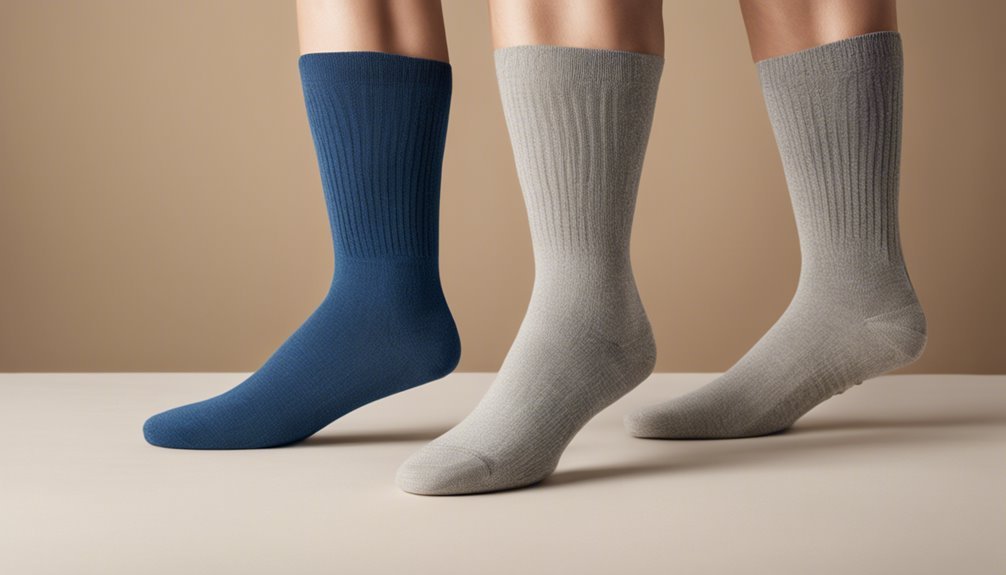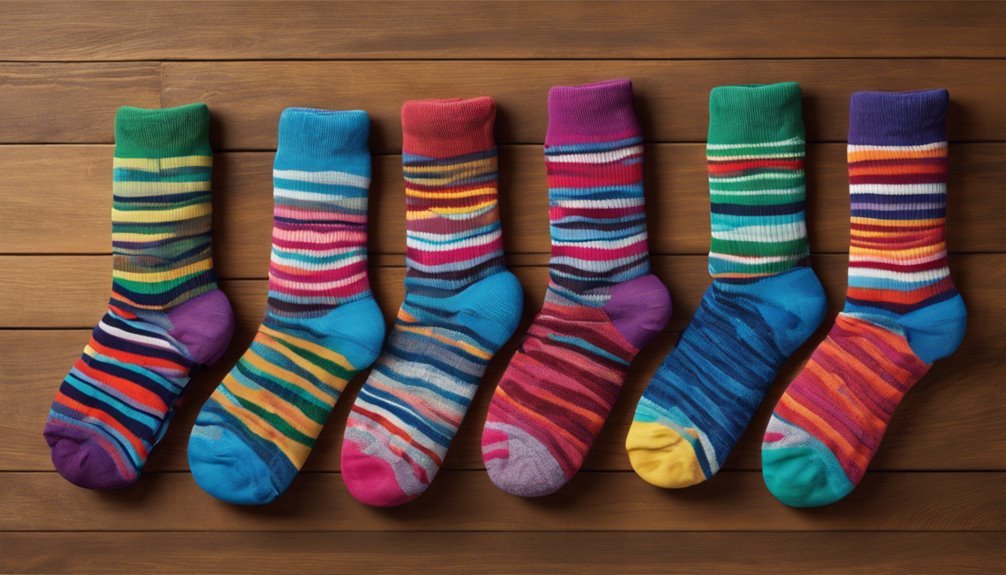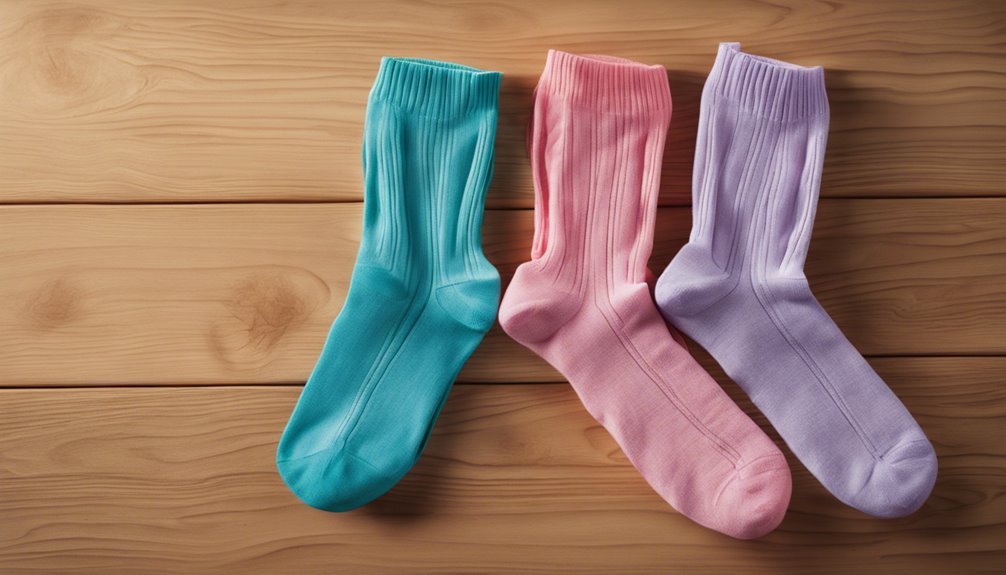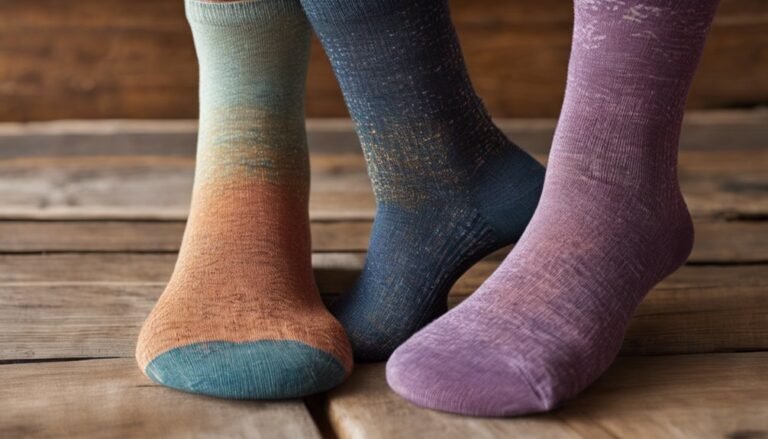Diabetic Socks vs. Regular Socks: What’s the Difference?
Imagine this: You're shopping for socks and find yourself staring at rows of seemingly identical pairs.
But what if some of these socks could play a crucial role in managing a medical condition like diabetes? Diabetic socks are not just ordinary socks; they are expertly crafted to meet specific foot care needs associated with diabetes, such as improving circulation and addressing neuropathy.
These specialized socks feature non-binding tops, seamless designs, and moisture-wicking fabrics to enhance comfort and prevent complications like infections and pressure points.
In contrast, regular socks, often made with constricting elastic bands and lacking therapeutic considerations, might exacerbate foot issues.
Choosing diabetic socks can be a game-changer for foot health, preventing injuries, and promoting an active lifestyle.
Discover more about the benefits and design differences.
Understanding the Importance of Foot Care in Diabetes

When managing diabetes, prioritizing foot care is essential to prevent complications that can arise from the disease. You've got to be proactive about maintaining blood circulation and addressing neuropathy management. Diabetes often impacts the peripheral nerves and circulation, leading to conditions that could restrict your mobility. It's vital to regularly monitor your feet for any changes, such as cuts, blisters, or signs of infection, as neuropathy might dull pain sensations. Optimizing blood circulation is fundamental; you'll want to incorporate strategies like gentle exercise and appropriate footwear. By taking these steps, you can minimize the risk of ulcers or more severe complications. Remember, effective foot care practices allow you the freedom to enjoy an active lifestyle without the constant worry of diabetic complications.
Key Features of Diabetic Socks
When considering diabetic socks, you'll find that their non-binding construction is essential in preventing circulation issues. These socks also utilize moisture-wicking materials to keep your feet dry and reduce the risk of infections. Seamless design features further enhance comfort by minimizing irritation and pressure that can lead to ulcers.
Non-Binding Construction
Although often overlooked, the non-binding construction of diabetic socks is an indispensable feature that distinguishes them from regular socks. These socks are designed to provide non-binding benefits, allowing for improved circulation, which is vital for individuals managing diabetes. Traditional socks can restrict blood flow, exacerbating complications. But with diabetic socks, you experience a gentle fit that eliminates constriction, promoting vascular health and reducing the risk of pressure points. This design enhances your freedom by ensuring comfort without compromising circulation. It's a patient-focused approach that prioritizes your health and autonomy. Embracing diabetic socks means choosing a path that supports your lifestyle and well-being, empowering you to maintain ideal foot health while enjoying the freedom of movement and comfort.
Moisture-Wicking Materials
While the non-binding construction of diabetic socks greatly enhances circulation, another pivotal feature is the use of moisture-wicking materials. These specialized fibers are designed to optimize moisture absorption, drawing sweat away from your skin. This is critical in maintaining a dry, comfortable environment, reducing the risk of fungal infections and skin breakdown. Proper moisture management is essential for you, especially if you're managing diabetes, as it helps prevent complications and promotes overall foot health.
Additionally, these materials aid in thermal regulation, ensuring your feet stay warm in cooler climates and cool in warmer settings. This adaptability offers you the freedom to engage in daily activities without worrying about discomfort. You'll experience a noticeable improvement in comfort and protection compared to regular socks.
Seamless Design Features
A crucial aspect of diabetic socks is their seamless design, which greatly reduces the risk of irritation and pressure points on sensitive skin. When you're managing diabetes, your feet require special attention to prevent complications. Seamless technology eliminates uncomfortable seams that can cause friction and compromise skin integrity, enhancing your comfort considerably. This advanced feature allows you to move freely without the constant worry of skin irritation or blisters, fostering a sense of independence.
From a clinical perspective, seamless socks are a proactive choice in diabetic foot care, reducing the potential for ulcer formation. For those desiring freedom from constant foot monitoring, seamless design provides the relief and security you need. Embrace comfort enhancement and safeguard your foot health with the right diabetic socks.
Benefits of Wearing Diabetic Socks
For individuals managing diabetes, choosing the right footwear can greatly impact foot health, which is why diabetic socks offer several advantages over regular socks. These specialized socks are designed to minimize the risk of foot complications, providing ideal support and protection. With gentle sock compression, diabetic footwear enhances circulation, reducing edema and promoting overall foot health. This feature is vital as it helps prevent ulcers and infections, common concerns for diabetic patients. In addition, the moisture-wicking properties of diabetic socks guarantee your feet stay dry, reducing the risk of fungal infections. The non-binding top of these socks allows for maximum comfort without constricting blood flow. By choosing diabetic socks, you're supporting your foot health while embracing the freedom to move with confidence.
Common Characteristics of Regular Socks

When considering regular socks, you'll notice their material often consists of cotton or polyester blends, which may not provide ideal moisture-wicking properties. The design typically includes elastic bands that can constrict circulation, a consideration for individuals with circulatory issues. While comfort is a focus, these socks may not address specific needs related to foot health, such as seamless construction to prevent friction and blisters.
Material and Construction
Regular socks, a staple in everyday attire, are typically crafted from materials like cotton, polyester, or a blend of both. When considering durability factors, these fabric types offer varying levels of resilience and comfort. Cotton, known for its breathability, can provide a sense of freedom, but may lack in moisture-wicking abilities, which is essential for effective foot care. Polyester, on the other hand, offers enhanced durability and elasticity, ensuring longer wear and retention of shape. From a clinical perspective, the construction of regular socks often includes reinforced heels and toes, designed to withstand daily wear and tear. However, these features might not provide the specialized support or protection required for individuals with specific medical needs, such as those with diabetes.
Design and Comfort
Although the design of regular socks caters to general comfort, they often prioritize aesthetic appeal over therapeutic benefits. You may find yourself drawn to sock aesthetics that express your individuality, yet it's important to understand their implications on foot health. Regular socks typically offer varied cushioning levels, but this may not suffice for those with specific medical needs. The focus on visual style often compromises the provision of features like seamless construction or non-binding tops, which are vital in minimizing pressure points and promoting circulation.
While the freedom to choose based on style is appealing, it's important to weigh the potential consequences on foot health. A balance between cushioning levels and sock aesthetics can be significant, especially for those with underlying health conditions requiring additional foot care.
Comparing Material and Design Differences
Diabetic socks, meticulously crafted to address the unique needs of individuals with diabetes, often differ considerably from regular socks in both material and design. You'll find that diabetic socks prioritize fabric types and cushioning levels to minimize irritation and enhance comfort. These socks frequently utilize moisture-wicking fabrics, like bamboo or wool, which help maintain a dry environment, essential for preventing complications. They often feature non-binding tops and seamless designs to reduce pressure and friction, fostering ideal blood circulation and preventing skin breakdown.
In contrast, regular socks might not offer such tailored features. They often lack the specialized cushioning levels necessary to protect sensitive diabetic feet. By understanding these distinctions, you're empowered to make informed choices that prioritize your foot health, granting you peace and liberation.
Choosing the Right Socks for Diabetic Foot Health

Understanding the material and design differences between diabetic and regular socks sets the stage for selecting the right socks for ideal foot health in individuals with diabetes. When choosing socks, focus on sock thickness and sock cushioning. Opt for socks with moderate thickness—providing sufficient cushioning without being too tight. This balance helps prevent pressure points and enhances blood circulation. Sock cushioning is essential; it reduces friction and minimizes the risk of ulcers or blisters. Look for seamless construction to avoid irritation. Diabetic socks often use moisture-wicking materials, keeping feet dry and lowering infection risk. Prioritize socks that offer gentle compression, enhancing venous return without constricting. With these considerations, you're free to make informed choices, optimizing foot health and comfort.
Frequently Asked Questions
Can Diabetic Socks Help Prevent Foot Ulcers?
While regular socks might constrict, diabetic socks enhance foot care with gentle compression, boosting blood circulation. This can help prevent foot ulcers by reducing pressure points and moisture, giving you the freedom to maintain healthier, ulcer-free feet.
Are There Specific Brands Recommended for Diabetic Socks?
You're probably wondering about brand recommendations for diabetic socks. Look for ones with seamless construction and moisture-wicking materials like bamboo or wool. Brands like Dr. Scholl's or MediPeds are often recommended, promoting foot health while ensuring comfort.
How Often Should Diabetic Socks Be Replaced?
You should replace diabetic socks every three to six months. This guarantees ideal wearing duration and maintains the integrity of sock materials. Prioritize your foot health by regularly checking for wear and tear, granting you freedom in movement.
Can Diabetic Socks Be Worn During Exercise?
Yes, you can wear diabetic socks during exercise. They're designed for moisture control and circulation enhancement, reducing risks of blisters and swelling. Enjoy your freedom to move safely, knowing they support your health and comfort.
Do Diabetic Socks Come in Different Styles and Colors?
You'll be pleased to know diabetic socks aren't just a one-trick pony. They offer diverse style options and color choices, ensuring both comfort and freedom. These socks cater to your medical needs while allowing personal expression.







